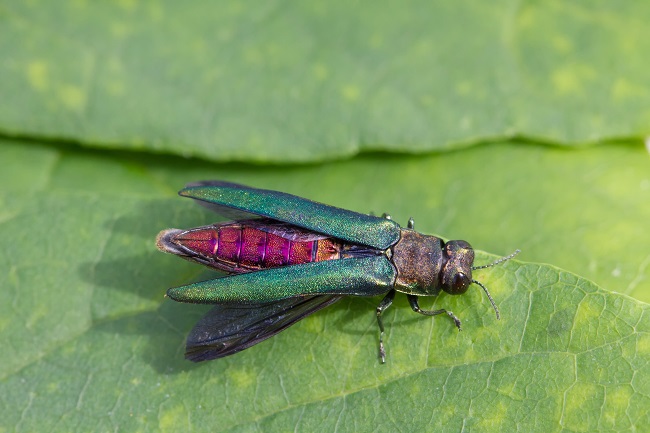Emerald Ash Borer – invasive beetle and destroyer of trees
If you go camping or to county, state, or national parks, you may be familiar with the name “emerald ash borer” from signs forbidding you from bringing in your own firewood. This is an attempt to keep this invasive species from spreading.

Emerald ash borers are a species of jewel beetle. They get their name from their brilliant green color and from the harm they do to ash trees. They are about half an inch long.
They are originally from Asia, where their population is comparatively low and they are not harmful. Because they don’t do much harm in their place of origin, there was little research done on emerald ash borers until they began decimating ash trees in North America and Europe. Most of the research being done on them is in the areas where they are a harmful and invasive species.
The adult beetles eat ash leaves but don’t do much damage. The damage is caused by larvae. The females lay eggs in cracks on the bark of ash trees. When the larvae hatch, they tunnel under the bark to feed. They continue to tunnel and eat the tender tissue between the bark and the wood. Their tunnels greatly harm the trees, eventually killing them via girdling.
They were first found in Michigan in 2002. Since then, they have spread to 29 more states and Canada. After a new area is infested, all ash trees will die within ten years unless active measures are taken to control the borers. They have killed millions of ash trees and cost municipalities, property owners, and forest product companies hundreds of millions of dollars.
Signs of infestation include:
D-shaped holes in the bark from adult beetles tunneling out of trees.
Heavy woodpecker damage–they like the larvae and will dig for them.
Canopy dieback–the leaves start to die at the top of the tree and eventually all are gone.
Split bark–tunnels are often seen through the split.
Epicormic shoots – shoots growing out from the base of the tree, often with leaves that are larger than normal.
Infestations in municipalities are treated using a multi-pronged approach. Wood from areas that have an infestation is quarantined. Infested trees are often removed, especially in towns or if they have taken a lot of damage. It has been identified less than 175 miles from DFW, and is on its way.
Biological controls are also being tried. In their native range, they are preyed upon by parasitic wasps. Four species of these have been okayed by the USDA and released. They have been observed to prey on emerald ash borers in the USA, but populations have not been stable so far. Other biological controls are being assessed.
Systemic insecticides, which are very effective, have an efficacy in the tree 1-2 years, particularly in trees that have not taken too much damage. Preemptive treatment is best when the infestations have been identified in the area. Tree Care Arborist (RCA/BCMA/CA)who are Certified and licensed through the state of Texas are the only Professionals qualified to prescribe and perform treatments.
For experienced help with emerald ash borer infestations, call Advanced Tree Care
